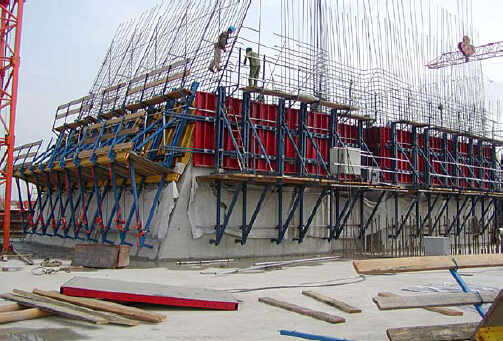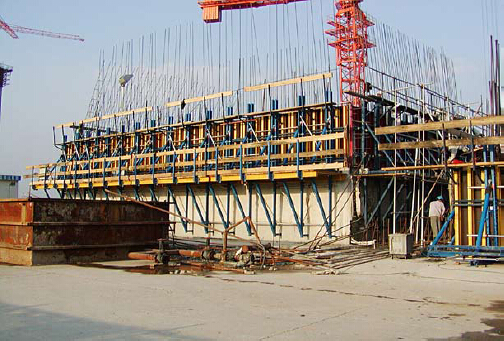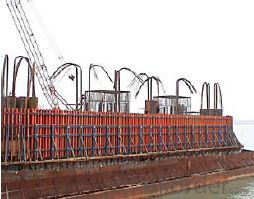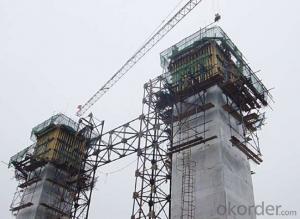Single-side Climbing Bracket SCB-180 for formwork and scaffolding systems
- Loading Port:
- Tianjin
- Payment Terms:
- TT OR LC
- Min Order Qty:
- 50 m²
- Supply Capability:
- 1000 m²/month
OKorder Service Pledge
OKorder Financial Service
You Might Also Like
Single-side Climbing Bracket SCB180:
With CNBM SCB 180 climbing systems, the loads from the fresh concrete pressure are transferred through the brackets by means of V-strongbacks and compression braces into the scaffold anchors.
Typical applications for the SCB 180 are dams, locks, cooling towers, pier heads, tunnels, and bank vaults.
The formwork is simply tilted backwards when striking takes place. The 1.80 m wide bracket requires only a minimum of space.
Characteristics:
◆ Economical and safe anchoring
The M30/D20 climbing cones have been designed especially for single-sided concreting using
SCB180 in dam construction, and to allow the transfer of high tensile and shear forces into the still
fresh, unreinforced concrete. Without wall-through tie-rods, finished concrete is perfect.
◆ Stable and cost-effective for high loads
generous bracket spacings allow large-area formwork units with optimal utilization of the bearing
capacity. This leads to extremely economical solutions.
◆ Simple and flexible planning
With SCB180 single-sided climbing formwork, circular structures can also be concreted without
undergoing any large planning process. Even use on inclined walls is feasible without any special
measures because additional concrete loads or lifting forces can be safely transferred into the
structure.


- Q: What are the different types of form ties used in steel formwork?
- There are several different types of form ties used in steel formwork, each designed to serve a specific purpose and meet specific requirements. 1. Coil Ties: These ties consist of a coil rod with two to four coils, which provide flexibility and allow for easy installation and removal. Coil ties are commonly used in lighter applications where relatively low pressure is expected. 2. Flat Ties: Flat ties are typically made of steel and have flat, wide plates on both ends. They are used to connect opposite wall forms, providing stability and preventing the forms from bulging or spreading due to the pressure of the concrete. 3. She-Bolt Ties: She-bolt ties consist of a threaded rod with a she-bolt attached to one end. These ties are used to secure wall forms together, and the threaded rod allows for easy adjustment of the formwork. 4. Snap Ties: Snap ties are a popular choice for fast and efficient formwork installation. They consist of a metal rod with a button-like head on one end and a wedge on the other. The button head is inserted into the formwork, and the wedge is then driven into the button head using a hammer, creating a strong connection. 5. Cone Ties: Cone ties are similar to snap ties, but they have a cone-shaped head instead of a button head. The cone head is inserted into the formwork, and a metal wedge is driven into the cone, securing the formwork. 6. Waler Ties: Waler ties are used to connect horizontal waler beams with vertical formwork members. They provide additional strength and stability to the formwork system. 7. Loop Ties: Loop ties are made of steel wire and have loops on both ends. They are used to secure wall forms together and can be easily removed once the concrete has cured. 8. Pin and Wedge Ties: Pin and wedge ties consist of a pin and a wedge. The pin is inserted into the formwork, and the wedge is driven into the pin, creating a tight and secure connection. These are just a few examples of the different types of form ties used in steel formwork. The choice of tie will depend on factors such as the type of construction, desired strength, ease of installation, and specific project requirements.
- Q: How does steel formwork affect the overall construction cost?
- The overall construction cost can be significantly impacted by steel formwork. Although the initial cost of steel formwork may be higher than that of timber or aluminum formwork, it offers various advantages that can lead to cost savings in the long run. To begin with, steel formwork is highly durable and has a longer lifespan when compared to other materials. This implies that it can be used multiple times, reducing the need for new formwork in future projects. Consequently, the cost of purchasing or renting formwork for subsequent projects decreases, resulting in overall cost savings. Furthermore, steel formwork is renowned for its strength and stability. This enables faster construction processes, as it can withstand higher concrete pressures, leading to quicker cycle times. The ability to achieve faster construction speeds can reduce labor costs and shorten the overall construction timeline, resulting in cost savings. Moreover, steel formwork ensures excellent quality and precision in concrete structures. It enables accurate shaping and forming of concrete elements, resulting in better finishes and fewer defects. This can reduce the requirement for additional finishing work, repairs, or rework, leading to cost savings in terms of materials and labor. Additionally, steel formwork enhances safety on construction sites. Its stability and strength enable it to withstand adverse weather conditions and prevent accidents. By ensuring a safe working environment, potential delays and costs associated with accidents or injuries can be minimized. Lastly, steel formwork is known for its versatility and adaptability. It can be easily customized to meet various project requirements, allowing for flexibility in design and construction. This versatility can lead to optimized construction processes and materials, ultimately reducing costs. In conclusion, although the initial cost of steel formwork may be higher, its durability, strength, speed, accuracy, safety, and versatility can result in significant cost savings in terms of reusability, labor, materials, and time. Therefore, steel formwork plays a positive role in the overall construction cost by providing long-term value and efficiency.
- Q: How does steel formwork contribute to the overall aesthetics of the structure?
- There are several ways in which steel formwork enhances the overall aesthetics of a structure. Firstly, it is renowned for its high-quality finish and smooth surfaces, which create sleek and visually pleasing concrete structures. The clean and uniform appearance achieved with steel formwork adds to the aesthetic appeal of the final product. Furthermore, steel formwork allows for greater design flexibility and creativity. Architects and designers can take advantage of the versatility of steel to create intricate shapes and curves that would be challenging with other formwork materials. This flexibility opens up possibilities for unique and attention-grabbing architectural features, enhancing the overall visual appeal of the structure. In addition, steel formwork provides a consistent and precise formwork system, resulting in accurate dimensions and sharp edges. This attention to detail contributes to the overall crispness and professionalism of the structure's aesthetics. Whether it's for exposed concrete walls, columns, or beams, steel formwork ensures a high level of precision and alignment, creating a polished and refined appearance. Moreover, steel formwork offers durability and longevity, making it an ideal choice for structures that require long-term aesthetics. Unlike other formwork materials that may deteriorate over time, steel is resistant to weathering, corrosion, and warping. This ensures that the structure maintains its aesthetic appeal for years to come, without compromising its structural integrity. Lastly, steel formwork promotes sustainability by being easily reusable, reducing waste. Construction companies can minimize their environmental footprint by using the same steel formwork for multiple projects. This emphasis on sustainability aligns with the modern design aesthetic that values eco-friendly practices, making steel formwork an attractive choice for architects and clients alike. To sum up, steel formwork contributes to the overall aesthetics of a structure through its high-quality finish, design flexibility, precise formwork system, durability, and sustainability. These factors combine to create visually appealing, sleek, and polished structures that stand out in their architectural beauty.
- Q: What are the common design considerations for steel formwork in heritage buildings?
- Some common design considerations for steel formwork in heritage buildings include ensuring that the formwork is compatible with the existing architectural features and materials, preserving the historical integrity of the building, providing adequate structural support, and facilitating ease of installation and removal without causing damage to the heritage elements. Additionally, considerations for weather resistance, durability, and fire safety may also be important factors in the design process.
- Q: How does steel formwork contribute to the overall energy efficiency of the building?
- Steel formwork contributes to the overall energy efficiency of the building in several ways. Firstly, steel formwork is highly durable and long-lasting, meaning that it can be reused multiple times for different construction projects. This reduces the need for new formwork materials, which in turn reduces the energy and resources required for manufacturing and transportation. Additionally, steel formwork allows for more precise and accurate construction, leading to tighter and better-insulated structures. This improved insulation helps to minimize heat transfer and air leakage, resulting in reduced energy consumption for heating and cooling. By providing a solid and airtight barrier, steel formwork helps to create a more energy-efficient building envelope. Furthermore, steel formwork enables the construction of complex shapes and designs, allowing architects to incorporate energy-efficient features such as passive solar heating, natural ventilation, and daylighting strategies. These design elements can significantly reduce the reliance on artificial lighting, heating, and cooling systems, further enhancing the overall energy efficiency of the building. Lastly, steel formwork is often used in conjunction with other sustainable building materials, such as recycled steel or eco-friendly concrete mixtures. This combination of materials enhances the overall sustainability of the construction process and reduces the environmental impact associated with traditional formwork materials. In summary, steel formwork contributes to the overall energy efficiency of the building through its durability, precision construction, ability to support energy-efficient designs, and use of sustainable materials. By incorporating steel formwork into a construction project, builders can help create buildings that are more energy-efficient, reducing their environmental footprint and promoting sustainable development.
- Q: What are the different types of form ties used in steel formwork systems?
- There are several different types of form ties used in steel formwork systems, each designed to provide a secure connection between the formwork panels and support structures. 1. Conventional Form Ties: These are the most commonly used form ties, consisting of a steel rod with cones or washers on both ends. The rod is inserted through the formwork panels and secured with nuts or wedges, providing a strong connection. 2. Coil Ties: These ties are made from a continuous loop of wire, often galvanized for corrosion resistance. They are easy to install and remove, and can be used for various concrete wall thicknesses by adjusting the length of the loop. 3. She-Bolts: Also known as she-bolts or coil bolts, these form ties consist of a threaded rod embedded in the concrete wall, with a plate and nut on the external side. They provide a solid connection and are commonly used in applications where the formwork needs to be removed and repositioned frequently. 4. Snap Ties: These ties feature a flat plate on one end and a snap-tie wedge on the other. They are quick and easy to install, requiring no special tools. Snap ties provide a reliable connection and are suitable for light to medium-duty applications. 5. Plastic Cone Ties: As the name suggests, these ties are made of plastic and are used with reusable plastic formwork systems. They are lightweight, easy to handle, and offer good resistance to chemical corrosion. 6. Flat Ties: Flat ties are flat strips or bars used to connect the formwork panels. They are typically made of steel and can be easily bent or cut to the desired length. Flat ties are often used in applications where the wall thickness is minimal. 7. Wedge Bolts: These form ties consist of a threaded rod with a wedge-shaped plate and nut. The wedge is inserted into a hole in the formwork panel, and tightening the nut secures the connection. Wedge bolts are commonly used in applications where high strength and quick installation are required. These are just a few examples of the different types of form ties used in steel formwork systems. The choice of form tie depends on factors such as the application, concrete wall thickness, required strength, and ease of installation and removal.
- Q: How does steel formwork compare to other formwork materials in terms of cost?
- Compared to timber or plywood, steel formwork generally carries a higher price tag. However, when considering the overall expenses of a construction project, steel formwork has the potential to save costs in the long run. Although the initial cost of steel formwork may be greater, it boasts exceptional durability and can be reused multiple times without compromising its structural integrity. This reusability feature diminishes the need for constant replacement or repair, ultimately reducing the overall expenses for formwork materials in the long term. Furthermore, steel formwork provides unparalleled strength, stability, and precision in shaping concrete structures, resulting in a superior final product. This, in turn, can lead to reduced labor expenses and shorter construction durations, effectively counterbalancing the initial investment in steel formwork. Moreover, steel formwork offers heightened safety due to its fire-resistant properties and ability to withstand extreme weather conditions. This lowers the chances of accidents or damage during the construction process, which can potentially result in savings on insurance costs. Although steel formwork may initially be more costly than alternative materials, it offers a multitude of advantages that can lead to cost savings throughout the entirety of the construction process.
- Q: What are the different types of steel formwork ties and connectors?
- In construction projects, various types of steel formwork ties and connectors are utilized. These ties and connectors play a vital role in securing and linking formwork panels, ensuring the stability and strength of the concrete structure under construction. 1. Snap Ties: Among the frequently employed formwork ties are snap ties. They comprise two components - a metal rod and a flat metal plate. The rod is inserted through the formwork panels and then snapped onto the plate, effectively holding the panels in place. 2. Wedge Ties: Another popular formwork tie option is wedge ties. They consist of a metal rod with a wedge-shaped end and a flat metal plate. The rod is inserted through the formwork panels, and the wedge is driven into a slot on the rod, creating a tight connection between the panels. 3. Loop Ties: Loop ties find common usage in situations where the formwork panels require easy adjustability or repositioning. They consist of a metal rod with a loop at one end and a flat metal plate at the other. The loop is inserted through the formwork panels, and the rod is bent to secure the panels together. 4. Flat Ties: Similar to snap ties, flat ties lack a snap mechanism. They are comprised of a flat metal plate with holes for inserting a metal rod. The rod is inserted through the formwork panels, and the flat tie is secured by twisting the rod or using a locking device. 5. Tie Rods: Tie rods work in conjunction with various formwork ties to provide additional strength and stability. These lengthy steel rods are inserted through the formwork panels and secured with nuts and washers on both ends. 6. Formwork Clamps: Formwork clamps serve as connectors to join and align formwork panels. Typically made of steel, they feature adjustable screws or bolts to tighten and secure the panels together. 7. Combi Nuts: Combi nuts are utilized in combination with tie rods and formwork clamps to connect and tighten formwork panels. They possess a threaded hole that allows the tie rod to pass through and secure the panels. These represent some of the prevalent forms of steel formwork ties and connectors found in construction projects. The appropriate type is selected based on factors such as the formwork system in use, load requirements, and the specific needs of the project.
- Q: Can steel formwork be used in areas with limited construction equipment access?
- Indeed, areas with limited access to construction equipment can still utilize steel formwork. Renowned for its durability and strength, steel formwork proves ideal for remote or challenging locales. Differing from other formwork types, steel formwork does not necessitate extensive machinery or equipment during installation. Instead, it can be conveniently transported and manually assembled, diminishing the reliance on heavy machinery. Furthermore, steel formwork is reusable, allowing for disassembly and relocation to different sites, if needed. Such adaptability renders steel formwork a pragmatic option for construction endeavors in equipment-constrained areas, guaranteeing efficient and cost-effective construction procedures.
- Q: What are the characteristics of steel formwork
- 3, the template adsorption force is small, easy demoulding.4, the number of turnover, generally can be used 50 times.
Send your message to us
Single-side Climbing Bracket SCB-180 for formwork and scaffolding systems
- Loading Port:
- Tianjin
- Payment Terms:
- TT OR LC
- Min Order Qty:
- 50 m²
- Supply Capability:
- 1000 m²/month
OKorder Service Pledge
OKorder Financial Service
Similar products
Hot products
Hot Searches

















